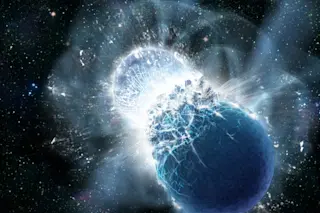For just the second time, physicists working on the Laser Interferometer Gravitational-Wave Observatory (LIGO) have caught the gravitational waves of two neutron stars colliding to likely form a black hole. The ripples in space time traveled some 500 million light-years and reached the detectors at LIGO, as well as its Italian sister observatory, Virgo, at around 4 a.m. E.T. on Thursday, April 25. Team members say there’s a more than 99 percent chance that the gravitational waves were created from a binary neutron star merger.
In the moments after the event, a notice went out alerting astronomers around the world to turn their telescopes to the heavens in hopes of catching light from the explosion, called a kilonova. Kilonovas are 1,000 times brighter than normal novas, and they create huge amounts of heavy elements, like gold and platinum. That brightness makes it easy for astronomers to find these events in ...














